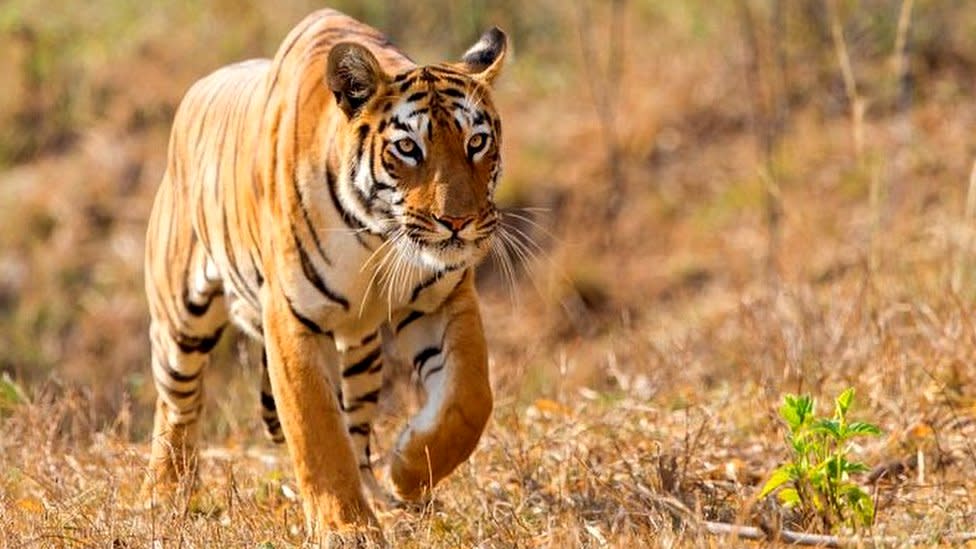Artificial Intelligence helping in keeping India’s tigers safe

Akhilesh Mishra, a veterinarian, has been attending to animals at Pench National Park in the Indian state of Madhya Pradesh for 22 years.
He is unafraid to say that his favorite animal is the tiger. “They are really amazing and lovely. I just have to touch their gentle skin to unwind “He claims. It is an extraordinary sensation when I can help a wounded tiger return to the forest after treatment.
He claims that a tiger’s existence is difficult, especially for the females: “For me, the female tiger is far more powerful than the male. She puts up such a brave fight for her cubs. She is a goddess, willing to fight off an enormous tiger that threatens to hurt her pups.”
Most of the tigers he treats had been hurt while out hunting or defending their cubs. He has, however, also cared for tigers that had been poisoned by poachers who had injected poison into ponds where they were known to drink.
“My heart cries when I see that people are slain for their skin, nails, and teeth without any of their faults,” he laments.
The task of protecting India’s tigers is huge because most of the country’s almost 3,000 tigers live in one of the country’s 51 tiger reserves, which occupy an area of nearly 74,000 square kilometers.
It is difficult to even estimate the overall tiger population.
India’s National Tiger Conservation Authority (NTCA) set up camera traps in 26,838 places for its most recent survey, which resulted in 34,858,623 photographs of animals being captured.
In addition, researchers walked tens of thousands of kilometers in search of evidence of tigers and their prey.
The NTCA used artificial intelligence (AI), which had been trained to recognize various animals, to sort through all of that data.
AI assisted in the 2018 study by recognizing the creatures captured by the video traps, a task that would have required a lot of time and effort from humans.
The NTCA now wants to advance the application of AI. To help rangers patrol the huge areas they are responsible for, a new technology is being designed.
It accomplishes this by analyzing information on the tiger population, its movements, and the topography of the area.
Mohmad Sajid Sultan, assistant inspector general at the NTCA, believes that artificial intelligence will aid rangers in identifying wildlife crimes.
More technology is certainly a good thing, but those involved in conservation claim that it cannot replace boots on the ground.
In protected parks, tiger conservation has been successful, but outside of such regions, tigers are still “very vulnerable,” according to environmentalist Debi Goenka.
The number of tigers is not likely to grow until we can improve the network of protected areas and wildlife corridors, he claims.
According to Mr. Goenka, better-equipped and more patrols made up of people are required.
“The best use of technology for monitoring and security would be to increase field patrolling. It is necessary to strengthen and intensify the use of drones, camera traps, real-time tracking of poachers, and metal detectors for finding snares and traps “He says.
As tigers and humans move closer together, thorough monitoring is more important than ever.
Tadaoba National Park in Maharashtra’s principal forest conservator is Sunil Limaye. He claims that during the past four years, the number of tigers in his state has climbed from 312 to 400.
The local population is notably encroaching on the woodlands where tigers dwell and hunt, thus as the tiger population has increased, so too has human contact.
Tigers have a bad reputation because of attacks on humans and cattle, the author claims.
According to Mr. Limaye, tigers are especially vulnerable when they travel from one forested region to another. In order to predict the movement of tigers at the edge of the forest, he is hoping that AI can be used in this situation.
The head of the AVI Foundation, Jerryl Banait, notes that poachers have advanced in sophistication. They avoid common pathways, map the rangers’ patrol patterns, and are aware of where the cameras are.
His organization has created an artificial intelligence that can utilise information gathered by cameras and rangers, as well as information gathered from satellites and local residents.
In the future, he believes that forest departments all around India would adopt this more advanced hybrid technology to conserve wildlife, especially species that are not now housed in National Parks or wildlife sanctuaries.
It is crucial that no one interferes with the already-dwindling natural habitats, he says, given the restricted regions that are accessible for wild creatures.
Akhilesh Mishra believes conservation efforts will help avoid tragedies like the passing of the well-known Baghin nala tigress, a tiger, which occurred back in Pench National Park.
The 12-year-old animal and two of her pups were poisoned and discovered dead in March 2016 in the Pench Tiger Reserve.
“It was a sight of delight when we grew her up in captivity, training her hunting abilities to survive in the tough wilderness,” Mr. Mishra said of the third cub he was able to save. Since then, the cub has thrived in the reserve and has offspring of its own.